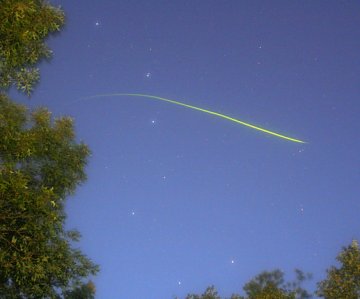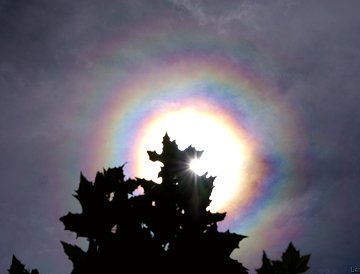| PLASMA BULLETS SPARK NORTHERN LIGHTS: Researchers have discovered what powers brilliant outbursts of Northern Lights: gigantic plasma bullets launched toward Earth by explosions 1/3rd of the way to the Moon. Get the full story from Science@NASA. LAMPYRIDID METEOR: Most meteors burn a straight path through Earth's atmosphere, but last week Doug Zubenel of De Soto, Kansas, photographed one that didn't--a lovely curving Lampyridid: 
"It's a firefly," says Zubenel. "While I was photographing the Big Dipper over our neighbor's oak trees, a bright green one left its serendipitous signature upon the CMOS sensor of my Canon Rebel XTi." Fireflies are nocturnal members of the beetle family Lampyridae. They meander curvaceously through the atmosphere producing their cold, green light via a biochemical reaction between oxygen and luciferin. Genuine meteors, on the other hand, produce their light by brute kinetic force. They race through the atmosphere at speeds exceeding 100,000 mph, heating the air to temperatures of 5000o C or more. Watch out Lampyridids, the real thing is coming. Earth is approaching a stream of debris from Comet Swift-Tuttle, the source of the annual Perseid meteor shower. First contact with the stream comes in the waning days of July. At first, only a few meteors per hour will flit across the night sky, but as Earth moves progressively deeper into the stream, the shower will intensify. Forecasters expect the Perseids to peak on Tuesday, August 12th, with a flurry of dozens and perhaps hundreds of shooting stars, straight-shooters all. Science@NASA has the full story. RINGS AROUND THE SUN: The next time you see a cloud approaching the sun, duck into the shadows and watch what happens. Monika Landy-Gyebnar of Veszprem, Hungary, followed these instructions, and here is her report: "Coming home from work I saw a nice altocumulus cloud drifting toward the sun. So I only had to find something to shade the sun and wait.... Soon, four rings appeared; they had wonderfully bright colors and completely encircled the sun." A 1/4000 second exposure at ISO 100 produced this image: 
This rainbow-colored apparition is not a rainbow, but "a corona," says atmospheric optics expert Les Cowley. "Coronas are much smaller than rainbows and are hard to see unless you shield the sun. They are the diffraction pattern produced when light waves bounce off small cloud droplets. One ring is usual, four are a rarity!" Other things you can see from the shadows: iridescence, ice halos and sundogs. The view is great and, on a hot summer day, it's a cool place to be. more images: from Kyle Rohr at Crater Lake, Oregon; from Emma Herranen of Tampere, Finland; from Bob King of Duluth, Minnesota; from Yasmin Angelique Walter of Dreieich, Germany; from Austin Taylor of Scalloway, Shetland Islands, UK; from Doug Zubenel of Johnson Co., Kansas
2008 Noctilucent Cloud Gallery
[Strange Clouds] [Sky Cameras] | 
